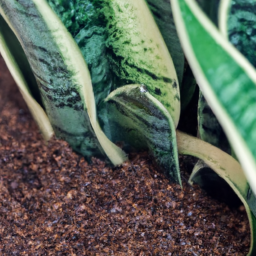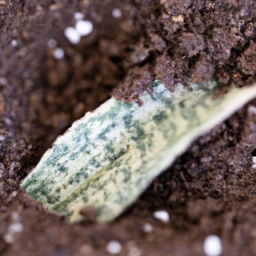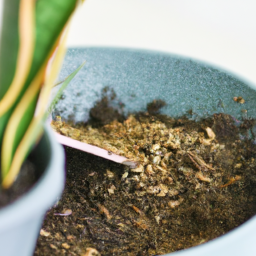
If you’re a proud owner of a snake plant, you probably already know that these low-maintenance beauties are perfect for adding a touch of green to any space. But did you know that the type of soil you use can have a big impact on the health and growth of your snake plant? In this blog post, we’ll explore the best type of soil for snake plants and share some tips on how to keep your plant thriving. So grab your gardening gloves and let’s dig in!
Types of Soil Suitable for Snake Plants
Hello plant lovers! If you’re a proud owner of a snake plant, you probably already know that these hardy plants are quite easy to care for. However, one crucial aspect of keeping your snake plant healthy and thriving is choosing the right type of soil. In this article, we will discuss the different types of soil that are suitable for snake plants and how to choose the best one for your green friend.
Well-Draining Soil
One of the most important factors to consider when choosing soil for your snake plant is its drainage capabilities. Snake plants are susceptible to root rot if their roots sit in waterlogged soil for too long. To prevent this, it’s crucial to choose a well-draining soil that allows excess water to flow through easily.
A good option for snake plants is a cactus or succulent mix, which is specially formulated to provide excellent drainage. You can also create your own well-draining soil mix by combining equal parts of potting soil, perlite, and coarse sand. This mix will ensure that your snake plant’s roots stay healthy and happy.
When repotting your snake plant, make sure to choose a pot with drainage holes at the bottom to further promote good drainage. This will help prevent water from pooling at the bottom of the pot and causing root rot.
Aerated Soil
In addition to good drainage, snake plants also require soil that is well-aerated to allow oxygen to reach their roots. Compacted soil can suffocate the roots and hinder their growth, leading to a decline in the overall health of the plant.
To ensure that your snake plant’s soil is well-aerated, you can add organic matter such as peat moss or compost to the soil mix. These materials will help loosen the soil and improve its overall structure, allowing for better air circulation around the roots.
It’s also important to avoid using heavy, clay-based soils for snake plants, as these can become compacted over time and restrict airflow to the roots. Opt for lighter, well-draining soil mixes that promote good aeration and root health.
Nutrient-Rich Soil
While snake plants are known for their ability to thrive in low-light conditions and with minimal care, they still require some nutrients to stay healthy and grow. Choosing a soil mix that is nutrient-rich will help provide your snake plant with the essential minerals it needs to thrive.
You can opt for a general-purpose potting soil that contains a balanced mix of nutrients, or you can supplement with a slow-release fertilizer specifically formulated for houseplants. Just be sure not to over-fertilize your snake plant, as this can lead to nutrient burn and other issues.
Regularly repotting your snake plant every 2-3 years with fresh, nutrient-rich soil will also help ensure that it continues to grow and thrive. This will give the plant a fresh start with a new supply of nutrients and promote healthy root growth.
By choosing the right type of soil for your snake plant, you can help ensure that it remains healthy and vibrant for years to come. Remember to provide good drainage, aeration, and nutrients to keep your snake plant happy and thriving!

Best Soil Mix for Snake Plants
Introduction
When it comes to caring for your snake plant, one of the most important factors to consider is the type of soil you use. The right soil mix can make a big difference in the health and growth of your plant. In this guide, we will discuss the best soil mix for snake plants and how to create the perfect environment for your plant to thrive.
Choosing the Right Soil Mix
When selecting a soil mix for your snake plant, it is important to consider the plant’s natural habitat. Snake plants are native to tropical regions of West Africa, where they grow in well-draining soil with plenty of organic matter. To recreate this environment at home, you will need a soil mix that is loose, well-draining, and nutrient-rich.
One of the best soil mixes for snake plants is a combination of potting soil, perlite, and sand. Potting soil provides the necessary nutrients for your plant to grow, while perlite and sand help to improve drainage and aeration. You can also add some peat moss or coco coir to help retain moisture in the soil, as snake plants prefer slightly moist conditions.
When mixing your soil, aim for a ratio of 2 parts potting soil to 1 part perlite and 1 part sand. This will provide the perfect balance of nutrients, drainage, and aeration for your snake plant. Be sure to mix the ingredients thoroughly to ensure an even distribution throughout the soil.
Tips for Maintaining Healthy Soil
Once you have chosen the right soil mix for your snake plant, it is important to take steps to maintain its health and fertility. One of the best ways to do this is by regularly fertilizing your plant with a balanced, water-soluble fertilizer. This will help to replenish the nutrients in the soil and promote healthy growth.
In addition to fertilizing, it is important to repot your snake plant every 2-3 years to refresh the soil and prevent root-bound conditions. When repotting, be sure to gently loosen the roots and remove any dead or rotting material before placing the plant in its new pot with fresh soil.
Finally, be sure to monitor the moisture levels in the soil and adjust your watering schedule accordingly. Snake plants prefer slightly moist conditions, so be sure not to overwater or let the soil become waterlogged. By following these tips and using the right soil mix, you can create the perfect environment for your snake plant to thrive.
In conclusion, choosing the right soil mix for your snake plant is essential for its health and growth. By selecting a well-draining, nutrient-rich soil mix and following these tips for maintenance, you can create the perfect environment for your plant to thrive. Remember to monitor moisture levels, fertilize regularly, and repot as needed to keep your snake plant happy and healthy.

Choosing the Right Soil for Your Snake Plant
As an expert in snake plants, I understand the importance of choosing the right soil for these unique plants. Snake plants, also known as Sansevieria, are popular houseplants due to their low maintenance and air-purifying qualities. However, in order for your snake plant to thrive, it is essential to provide it with the proper soil conditions. In this guide, I will discuss the best type of soil for snake plants and provide you with step-by-step instructions on how to create the perfect soil mix for your beloved plant.
Understanding the Needs of Snake Plants
Before we dive into the specifics of soil mixtures, let’s first understand the needs of snake plants. Snake plants are native to arid regions of Africa and are accustomed to well-draining soil with minimal moisture retention. They prefer soil that is slightly sandy and gritty, allowing for proper aeration and drainage. Additionally, snake plants are sensitive to overwatering, so it is crucial to use a soil mix that will not hold excess water.
When selecting soil for your snake plant, it is important to consider the pH level as well. Snake plants thrive in slightly acidic to neutral soil, with a pH range of 6.0 to 7.5. Ensuring that your soil is within this pH range will help promote healthy growth and prevent nutrient deficiencies in your plant.
Now that we have a better understanding of the needs of snake plants, let’s discuss the best type of soil mix for these unique plants.
Creating the Perfect Soil Mix for Snake Plants
When creating a soil mix for your snake plant, it is important to use a combination of well-draining materials that will mimic the plant’s natural habitat. A popular soil mix for snake plants includes a combination of potting soil, perlite, and coarse sand. Potting soil provides the necessary nutrients for your plant, while perlite and sand help improve drainage and aeration.
Start by mixing equal parts potting soil, perlite, and coarse sand in a large container. Thoroughly combine the materials to ensure an even distribution of each component. The perlite and sand will help prevent soil compaction and allow excess water to drain freely, reducing the risk of root rot in your snake plant.
Once you have created your soil mix, carefully transfer your snake plant into a well-draining pot with drainage holes at the bottom. Fill the pot with the soil mix, ensuring that the plant’s roots are covered but not buried too deeply. Gently pat down the soil to secure the plant in place and water thoroughly, allowing any excess water to drain out of the pot.
Maintaining Healthy Soil for Your Snake Plant
After repotting your snake plant, it is important to monitor the soil moisture levels regularly. Snake plants prefer to dry out between waterings, so be sure to allow the top inch of soil to dry before watering again. Overwatering can lead to root rot and other issues, so it is essential to maintain proper soil moisture levels for your plant’s health.
In addition to proper watering, you can also fertilize your snake plant every 2-3 months during the growing season. Use a balanced liquid fertilizer diluted to half strength to provide your plant with the necessary nutrients for healthy growth. Avoid over-fertilizing, as this can lead to nutrient imbalances and damage to your snake plant.
By following these steps and providing your snake plant with the right soil conditions, you can ensure that your plant thrives and remains healthy for years to come. Remember to monitor your plant’s growth and adjust your care routine as needed to meet its changing needs. With the proper soil mix and care, your snake plant will continue to be a beautiful and low-maintenance addition to your home.
Key Takeaways of this article
When it comes to caring for your snake plant, choosing the right type of soil is crucial for its health and growth. Snake plants, also known as sansevierias, are known for their hardiness and ability to thrive in various conditions, but having the right soil can make a big difference.
Ideally, snake plants prefer a well-draining soil mixture that is slightly sandy and has good aeration. A mix of potting soil, perlite, and coarse sand is a great option for snake plants as it allows excess water to drain away quickly, preventing root rot. Avoid using heavy, compacted soils that retain too much moisture, as this can lead to problems like root rot and fungal diseases. By choosing the right soil for your snake plant, you can help ensure that it stays healthy and continues to thrive in your home or garden.
Frequently Asked Questions (FAQ):
Q1. What type of soil is best for snake plants?
A1. Snake plants thrive in well-draining soil that is slightly sandy and loamy. A good mix would be a combination of potting soil, perlite, and coarse sand.
Q2. Can snake plants grow in regular garden soil?
A2. Snake plants prefer a soil mix that is well-draining and not too compact. Regular garden soil may not provide the proper drainage needed for snake plants to thrive.
Q3. Should I use fertilized soil for my snake plant?
A3. It is best to avoid using fertilized soil for snake plants as they are sensitive to over-fertilization. Opt for a well-draining soil mix and only fertilize sparingly during the growing season.
Q4. How often should I repot my snake plant to refresh the soil?
A4. Snake plants are known to be low-maintenance and can go several years without needing to be repotted. It is recommended to refresh the soil every 2-3 years or when the plant has outgrown its current pot.
Q5. Can I use cactus soil for my snake plant?
A5. While cactus soil is well-draining and similar to the soil mix that snake plants prefer, it may not provide enough nutrients for the plant. It is best to use a mix specifically tailored for snake plants for optimal growth.
Dr. Olivia Green is a botanist with over two decades of experience in indoor plant cultivation. She holds a Ph.D. in Plant Biology and has dedicated her career to researching plant behavior in controlled environments. Dr. Green is passionate about helping plant enthusiasts master the art of indoor gardening through her extensive knowledge and practical insights.


